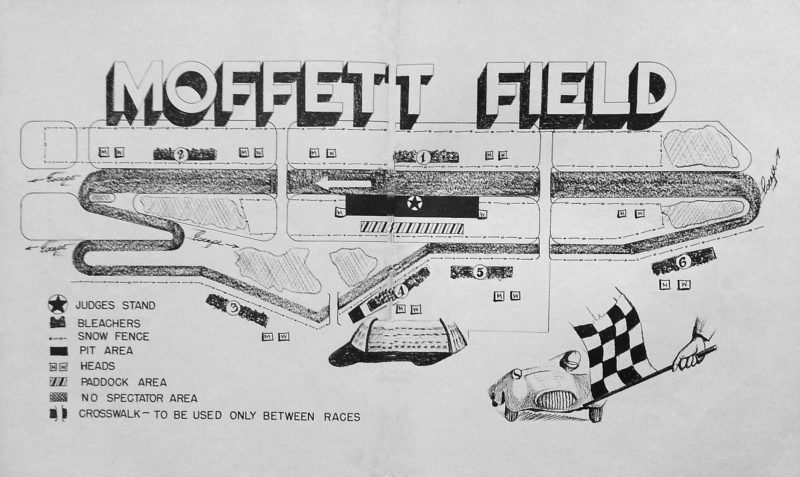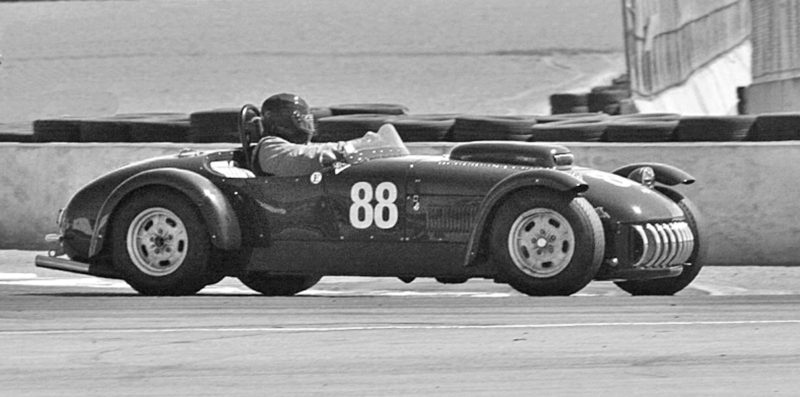Notes From The Archives – Moffett Field
April 12, 2018Moffett Field
Words by: Gary Horstkorta
August 16, 1953 was the date for the inaugural road races at Moffett Field, the former World War II Naval Base for Lighter-Than-Air blimps in Mountain View, CA. With the huge blimp hangers as a backdrop, a rectangular course with rounded corners utilized the fields runways and taxiways. It didn’t take an experienced race spectator to know this layout would obviously give the advantage to cars with high horsepower.

Race program cover with the famous Hangar-1 blimp hangar in background
One such car entered was the new Mercury V-8 powered Kurtis Sports Car built by Frank Kurtis and driven by Bill Stroppe. Coming into the Moffett race, the Kurtis had won five consecutive events including the previous week,s race in Seattle, where Stroppe had reached 120 mph on one stretch of the 2.1 mile airport course. The Kurtis car design closely followed the general chassis and suspension layout of the Indianapolis car that Bill Vukovich used to almost win the previous years 500 mile event. The Kurtis Sports Car used a combination of tubes and flat sheet metal sections to form a stiff and low profile chassis. Solid axles, front and rear, with each suspended by trailing arms and torsion bars…simple but very effective at putting the V-8 power to the ground. Six cars had been built, ten were in production and twenty more were planned. There was even talk of entering the Kurtis in the Le Mans 24 hour race in 1954.

Moffet Field track map of 2.1 miles
With the demand for purpose built race cars growing, Frank Kurtis wanted to tap this market by offering several “kit” versions of his sports car. Selling for a planned $3,000.00, the kit would offer a complete frame, front & rear suspension, radiator, steering and complete body. Drop in your V-8 and transmission of choice, add brakes, axles, instruments, throw on some tires and go challenge the “big boys”.

Kurtis similar to the one Bill Stroope raced in to victory.
Pre-race attention centered on the likely duel between Phil Hill in his new 3 liter Ferrari and Stroppe in the Mercury Kurtis. With the promise of a close an exciting race, 50,000 spectators lined the course to see what the results would be. Three races were on the program, the Captains Cup for 1500cc and Under cars; the Novice Race and the Moffett Handicap open to all senior entrants. The Novice Race was won by Robert Cardwell in a Chrysler/Allard with an average speed of 77 mph followed by John Barnum in a Cad/Allard and in third, driving a Frazer-Nash, a driver who would eventually race the vaunted Scarabs, Chuck Daigh.

Al Coppel in his OSCA races to a 2nd place finish.
The Captains Cup of 77 miles was to have been a four way duel between Jack McAfee’s Porsche, Ken Miles MG Special, Al Coppel’s OSCA and Chick Leson’s Simca Special. Unfortunately both Miles and Coppel dropped out with mechanical troubles which left McAfee to control the race with Leson coming in second. This was a rare defeat for Miles who had been dominating races in his MG Special, the R-1.

Ignacio Lozano Jaguar leads a group down to Turn 6.
All eyes were now focused on the grid as the main event, the 2 1/h hour long, Moffett Handicap, was awaiting the green flag. An interesting mix of cars were in the field – a GMC powered Aston Martin; a Morgan Plus Four; a Sunbeam Alpine; a Jaguar XK-120M; several Allards; a Siata Spyder; several MGs and a Simca Sprecial. Miles had repaired his R-1 in which he hoped to give both Phil Hill and Stroppe a run for their money despite having an engine half their size. The anticipated duel between Hill and Stroppe ended as the flag fell. After a LeMans start, Hill’s race lasted exactly three feet as his rear axle snapped and he could do nothing but sit and watch the other cars race away. With Hill now sidelined, Stroppe slipped into the lead and progressively moved away from the rest of the field and won easily. To those watching the race it was evident the Kurtis/Mercury was handling beautifully. After the race, Stroppe said “it never feels like its slipping and doesn’t heel on the corners. The rear suspension tends to spot the chassis into the rear end and the car simply squats on acceleration”. Following Stroppe home in second was the Aston Martin/GMC and amazingly, Ken Miles in his 1500cc MG/R-1.

A Le Mans start was used for the feature race.
Almost as impressive as the performance of the Kurtis was the efficiency of Stroppe’s pit crew. The speed and organization of most pit crews had to this point in sports car racing been pretty amateurish. Stroppe’s crew was not your usual assemblage of mechanics or friends, rather they were an experienced group that had handled the duties for Vukovich’s 1953 Indy 500 winning car and for Chuck Daigh in the previous years Mexican road race. With fifteen minutes left in the main event, Stroppe came in for a pit stop. Six crewmen sprang into action and in less than 50 seconds, fuel was added and two new rear tires were changed before he accelerated back onto the course. The elapsed time compared favorably with an Indianapolis pit stop and had this race been closer, Stroppe’s pit crew could very well have made a difference.

